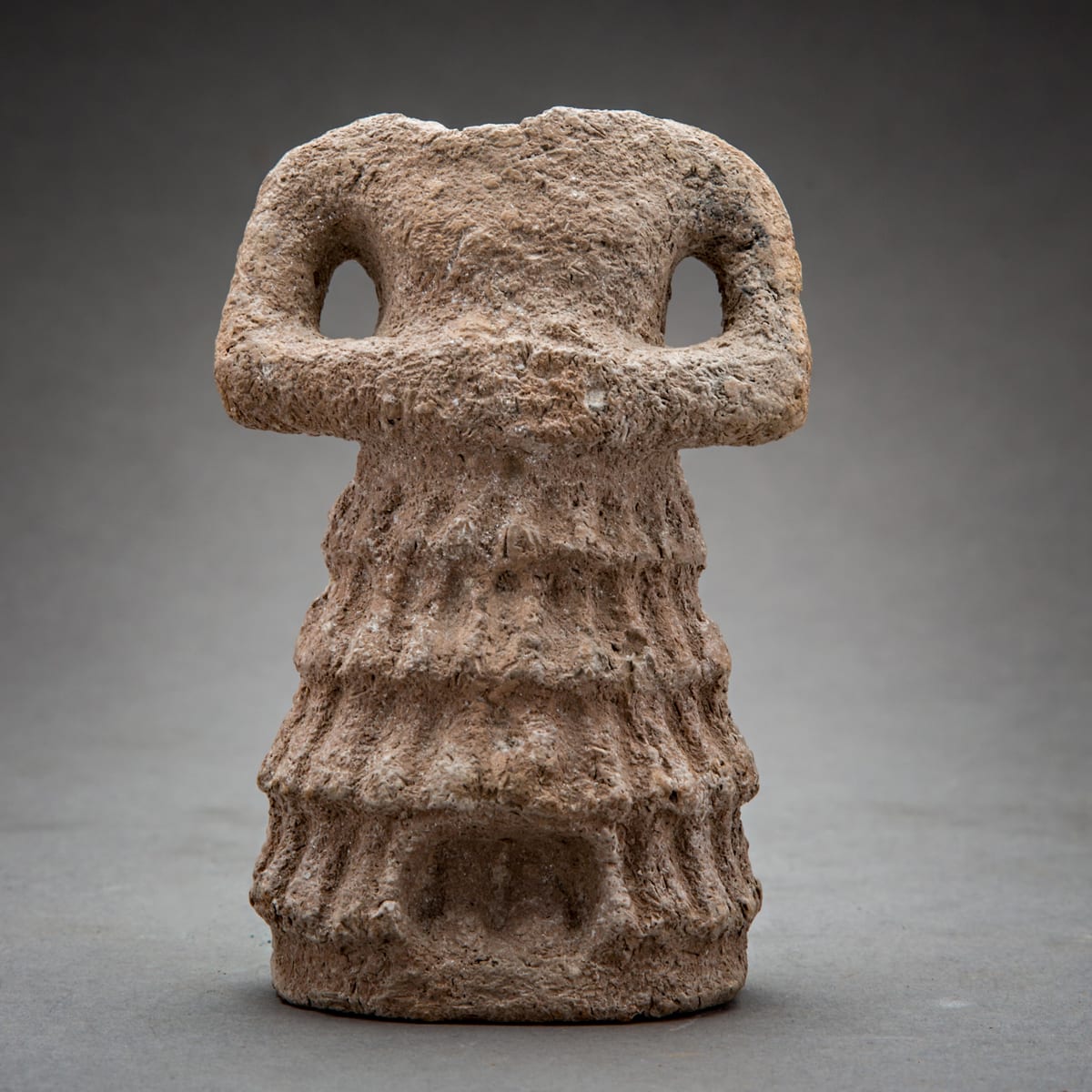Sumerian headless male figurine, 3000 BCE - 2300 BCE
Stone
height 11.4 cm
height 4 1/2 in
height 4 1/2 in
PH.0176
Sumer is the earliest known civilization in the historical region of southern Mesopotamia, during the Chalcolithic and Early Bronze ages, and arguably the first civilization in the world, thus generally...
Sumer is the earliest known civilization in the historical region of southern Mesopotamia, during the Chalcolithic and Early Bronze ages, and arguably the first civilization in the world, thus generally considered as the cradle of civilization. Living along the fertile valleys of the river Tigris and Euphrates, Sumerian farmers were able to grow an abundance of grain and other crops, the surplus of which enabled them to settle in one place. In relevance to the above, the name Sumer came also to indicate what was the southernmost region of ancient Mesopotamia, more or less corresponding to modern-day Iraq and Kuwait.
Sumerian alabaster figurine of a male worshipper. The worshiper is wearing an ankle length woolen skirt with layers of tufted borders, the so-called kaunakes, which was probably the archetypal ceremonial garment in the Mesopotamian Bronze Age.
Votive statues are of various sizes and usually carved in gypsum or limestone. They depict men wearing fringed or tufted fleece skirts, and women wearing fringed or tufted dresses draped over one shoulder. Many have inlaid eyes and painted hair. The statues are usually carved with the hands clasped, right over left, at the chest or waist in a gesture of attentiveness. Some figures hold cups or branches of vegetation. Standing figures often step forward with the left foot. Male heads are frequently shown bald but sometimes wear beards, while female figures can have a variety of hairstyles or headdresses. Facial characteristics offer little variation from one statue to the next. Archaeological excavations in Mesopotamian temples have revealed a large number of both male and female figurines that devotees commissioned and dedicated to various deities, as a visible testimonial of their faith but also as to introduce a constant presence as a reminder of their generous piety near the deity. Typologically, while men and women are equally attested, standing statuettes are among the most common. Such ex-votos were deposited at the foot of the altar or on an offering table in the temple; they have been often discovered buried in votive deposits, where they were carefully deposited when the temples or the sanctuaries had to be cleared, as to make room for new offerings. Such statuettes were offered by prominent figures of the royal court or of the local administration, by members of the religious staff, by wealthy merchants or dignitaries and by members of the aristocracy and the royal families. The presence of an inscription, usually engraved in the back, could indicate the name and rank of the person who dedicated it. Stylistically, this figurine is related to certain objects excavated at Mari and can therefore be dated to the middle of the 3rd millennium BC.
Sumerian alabaster figurine of a male worshipper. The worshiper is wearing an ankle length woolen skirt with layers of tufted borders, the so-called kaunakes, which was probably the archetypal ceremonial garment in the Mesopotamian Bronze Age.
Votive statues are of various sizes and usually carved in gypsum or limestone. They depict men wearing fringed or tufted fleece skirts, and women wearing fringed or tufted dresses draped over one shoulder. Many have inlaid eyes and painted hair. The statues are usually carved with the hands clasped, right over left, at the chest or waist in a gesture of attentiveness. Some figures hold cups or branches of vegetation. Standing figures often step forward with the left foot. Male heads are frequently shown bald but sometimes wear beards, while female figures can have a variety of hairstyles or headdresses. Facial characteristics offer little variation from one statue to the next. Archaeological excavations in Mesopotamian temples have revealed a large number of both male and female figurines that devotees commissioned and dedicated to various deities, as a visible testimonial of their faith but also as to introduce a constant presence as a reminder of their generous piety near the deity. Typologically, while men and women are equally attested, standing statuettes are among the most common. Such ex-votos were deposited at the foot of the altar or on an offering table in the temple; they have been often discovered buried in votive deposits, where they were carefully deposited when the temples or the sanctuaries had to be cleared, as to make room for new offerings. Such statuettes were offered by prominent figures of the royal court or of the local administration, by members of the religious staff, by wealthy merchants or dignitaries and by members of the aristocracy and the royal families. The presence of an inscription, usually engraved in the back, could indicate the name and rank of the person who dedicated it. Stylistically, this figurine is related to certain objects excavated at Mari and can therefore be dated to the middle of the 3rd millennium BC.



